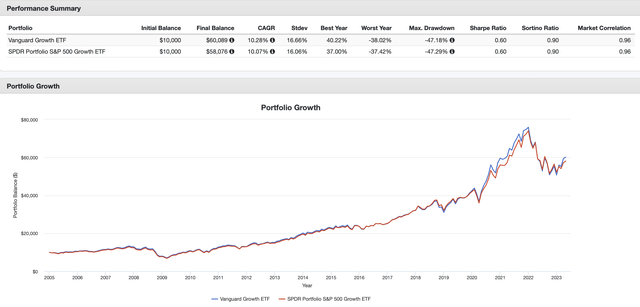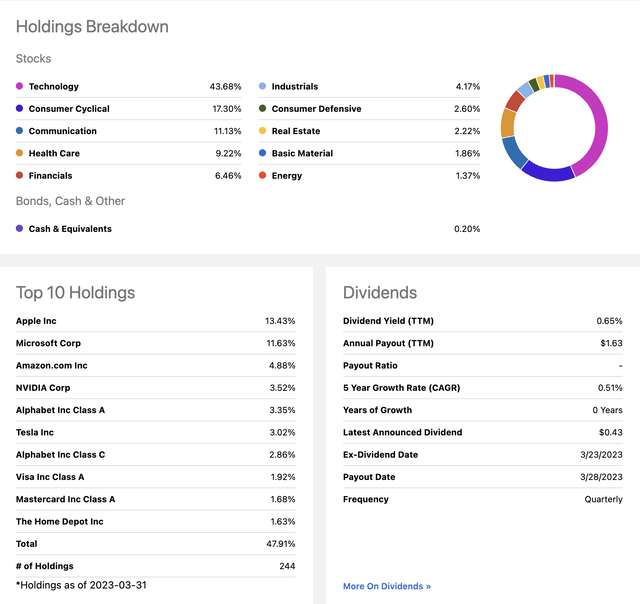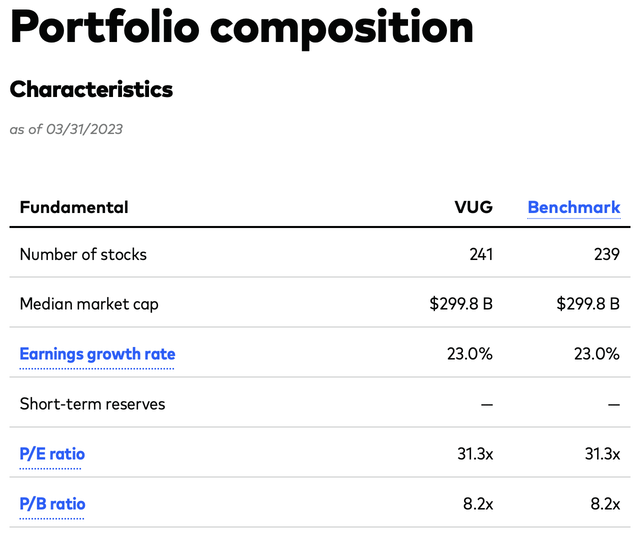VUG: A Wonderful Growth ETF, But Tread Cautiously At This Precise Moment
Summary
- VUG has a long track record, an ultra-low expense ratio, and a very solid method of portfolio selection. For risk-tolerant investors, with a long-term perspective, it's an excellent choice.
- At the same time, for many investors, I have some real concerns about either initiating a new position, or adding to a position, at this precise moment in time.
- In the article, I will both explain why and what I suggest you consider as alternatives.
- Looking for more investing ideas like this one? Get them exclusively at Hoya Capital Income Builder. Learn More »
picture
(This article was co-produced with Hoya Capital Real Estate.)
In this article, I will take my first ever look at Vanguard Growth ETF (NYSEARCA:VUG).
As featured in my title for the article, for investors with a long-term perspective, and who can tolerate a reasonable amount of risk, this is an excellent ETF. At the same time, I will offer what I believe to be a couple of cautions at this particular point in time.
Without further ado, let's dig in and have a look at the makeup of the fund, and what has made it a proven winner over the long term.
Vanguard Growth ETF - A Proven Winner
Put simply, VUG boasts an incredible track record. With an inception date of January 30, 2004, VUG has a history back to some of the earliest days of ETFs, and will celebrate its 20th anniversary in less than a year. According to the latest data on its Vanguard web page, VUG boasts some $81.6 billion in AUM in the ETF itself, and has a total AUM of $157 billion when its mutual-fund class shares are included. As with so many Vanguard funds, expenses are rock bottom, with an expense ratio of .04% and an average trading spread of .03%. I'll touch a little more on that trading spread just a little later.
VUG seeks to track the performance of the CRSP US Large Cap Growth Index. Here, from the most recent CRSP-provided quarterly report, is a brief description of the index.
Once securities are assigned to a size-based market cap index, they are made eligible for assignment to a growth or value index using CRSP's multifactor model.
CRSP classifies growth securities using the following factors: future long-term growth in earnings per share (EPS), future short-term growth in EPS, 3-year historical growth in EPS, 3-year historical growth in sales per share, current investment-to-assets ratio, and return on assets.
Additionally, the index makes use of some interesting techniques to minimize trading and its associated costs. First of all, for a holding to move into this index, its style traits or market-cap must change considerably. Should that occur, the fund initially trades only 50% of the stock's market cap to protect against one-off fluctuations. Next, when the fund does rebalance, it spreads trades over five days to mitigate market impact costs.
All of this results in a fund with very low turnover. Morningstar reports that over the past five years, turnover has averaged 9%, ranking among the lowest in its category. That relates back to that .03% trading spread I referenced earlier. Even though there are ETFs that boast an even lower trading spread, there is a high likelihood that their turnover ratio is higher, perhaps much higher, meaning that VUG's ultimate costs are extremely low.
Over long spans of time, that has led to solid performance. As one quick reference, below are the results of a backtest comparing VUG against SPDR Portfolio S&P 500 Growth ETF (SPYG), an excellent competitor, over the period covering January, 2005 until the present.
VUG vs. SPYG: 2005 - Present (PortfolioVisualizer.com)
As can be seen from the respective Sharpe and Sortino ratios, the risk/reward balance between these two funds is virtually identical. At the same time, VUG has managed to generate a bit more in total return for its shareholders.
A Balancing Perspective - Reasons For Caution
At the same time, I believe there are some reasons for caution for investors considering opening a new position, or adding to their holdings, in VUG at the present time.
To share my concerns, let's start with a beautiful combo graphic that I have been using in so many of my reviews of late, from the Seeking Alpha webpage for VUG.
VUG: Portfolio Characteristics (Seeking Alpha)
As can quickly be seen, VUG has become very heavily weighted in the technology sector, which currently comprises some 43.68% of its holdings. Even more pronounced is the fact that its two largest holdings, Apple Inc. (AAPL) and Microsoft Corporation (MSFT), comprise a full 25% of the fund.
As a reference point, Morningstar reports that, since early 2020, VUG's top 10 holdings have grown in concentration to 49% from 40% as these industry stalwarts continued to grow larger in relative terms compared to the overall market.
Where does that leave the fund at the present time in terms of valuation, or how 'expensive' it is as compared to the overall market? For a quick look at that, we turn to the Portfolio Composition page for VUG from Vanguard's website, linked earlier in the article.
VUG: Portfolio Composition (Vanguard)
As can quickly be seen, this is a very 'expensive' fund at this point in time, with a P/E ratio of 31.3 and a P/B ratio of 8.2.
As just two recent references for comparison, in my most recent article for Seeking Alpha I reviewed Vanguard Total International Stock ETF (VXUS), and encouraged investors not to sell this ETF even in the face of recent outperformance compared to U.S. stocks.
Here is an excerpt from my reasoning in that article.
The latest data on the Vanguard website, as of 3/31/23, show an overall P/E ratio of 12.5 and P/B ratio of 1.6 for VXUS, as opposed to 19.7 and 3.5, respectively for VTI, its U.S. counterpart. Finally, investors interested in income as a component of total return may wish to take note of that 2.88% dividend yield.
As can be seen, if one purchases VUG at the present time, one is purchasing a basket of stocks with P/E and P/B ratios roughly 1.5 - 2x those of the U.S. market as a whole, and somewhere in the area of 3x that of international stocks.
With respect to that, I could probably share a bunch of graphics, or a long-winded explanation, to attempt to convey my concerns with that at the present time.
Perhaps, though, the most succinct way to do so is via a tweet that happened to catch my attention the other day. Take a look and see what you think.
As the author of the tweet acknowledges, there are factors that are different this time. At the same time, reading Druckenmiller's words, I find myself with real concerns.
Anecdotally, here is just one. The New York Fed continues to report that U.S. household credit card debt continues to rise. I love Apple, and its products. In fact this article is being written on my iMac, as I review my personal portfolio on my MacBook and check Twitter on my iPad and iPhone. At the same time, I haven't in any way been moved to trade in my iPhone 13 Pro for one of the iPhone 14 variants even though, happily, household debt is not a problem for me. And yet, as I write this, AAPL stock hovers near all-time highs.
Summary And Conclusion
In this article, I have enumerated all the reasons why VUG is a top-quality ETF. If one leans toward being a buy-and-hold investor, and has a long-term perspective, this ETF is certainly worthy of serious consideration.
At the same time, for purposes of this article, I am going to rank it a 'sell' from a timing standpoint. For the reasons I have enumerated above, I believe you would be safer sticking to a total-market ETF such as Vanguard Total Stock Market ETF (VTI) for your desired allocation to domestic stocks. Even further, I would recommend a diversified portfolio, including a healthy allocation to cash and bonds at this point in time as well as, as recommended in my last article, at least some allocation to international stocks.
As always, I hope you have found this article both interesting and helpful. Please, join the conversation and let me know your take on matters in the comments section below.
ETF Monkey Teams Up With Income Builder
ETF Monkey has teamed up with Hoya Capital to offer the premier income-focused investing service on Seeking Alpha. Members receive complete early access to our articles along with exclusive income-focused model portfolios and a comprehensive suite of tools and models to help build sustainable portfolio income targeting premium dividend yields of up to 10%.
Whether your focus is High Yield or Dividend Growth, we’ve got you covered with actionable investment research focusing on real income-producing asset classes that offer potential diversification, monthly income, capital appreciation, and inflation hedging. Start A Free 2-Week Trial Today!
This article was written by
Analyst’s Disclosure: I/we have a beneficial long position in the shares of VTI either through stock ownership, options, or other derivatives. I wrote this article myself, and it expresses my own opinions. I am not receiving compensation for it (other than from Seeking Alpha). I have no business relationship with any company whose stock is mentioned in this article.
I am not a registered investment advisor or broker/dealer. Readers are advised that the material contained herein should be used solely for informational purposes, and to consult with their personal tax or financial advisors as to its applicability to their circumstances. Investing involves risk, including the loss of principal.
Seeking Alpha's Disclosure: Past performance is no guarantee of future results. No recommendation or advice is being given as to whether any investment is suitable for a particular investor. Any views or opinions expressed above may not reflect those of Seeking Alpha as a whole. Seeking Alpha is not a licensed securities dealer, broker or US investment adviser or investment bank. Our analysts are third party authors that include both professional investors and individual investors who may not be licensed or certified by any institute or regulatory body.

